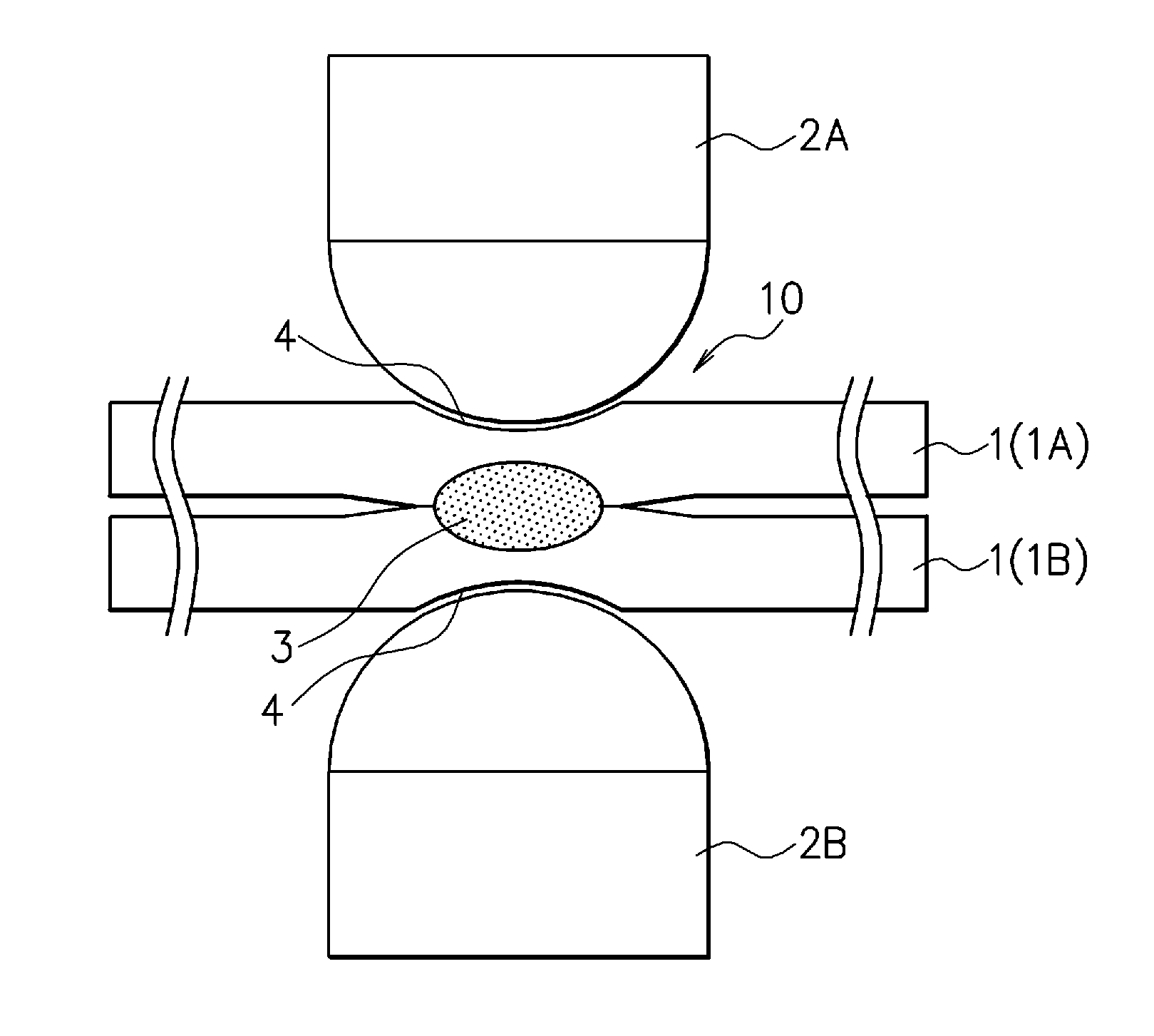Spot welding method of high-strength steel sheets excellent in joint strength
a high-strength steel sheet and welding method technology, applied in welding electric supplies, welding apparatus, manufacturing tools, etc., can solve the problems of insufficient joint strength, high-strength steel sheet is more difficult to fit with electrodes, low ductility and toughness of weld metal, etc., to prevent the occurrence of expulsion, excellent joint strength, and high reliability
- Summary
- Abstract
- Description
- Claims
- Application Information
AI Technical Summary
Benefits of technology
Problems solved by technology
Method used
Image
Examples
first embodiment
[0076]Hereinafter, a first embodiment of the spot welding method of the high-strength steel sheets according to the present invention will be described. The spot welding method of the high-strength steel sheets of the first embodiment is a method of welding two steel sheets 1A, 1B or three steel sheets 1A to 1C by resistance spot welding in order to obtain a spot-welded joint 1C illustrated in FIG. 1 and FIG. 2.
[0077]Concretely, when the two steel sheets 1A, 1B are spot-welded as illustrated in FIG. 1, these two steel sheets 1A, 1B both have tensile strength of 780 to 1850 MPa. Further, a sheet thickness ratio={the sum of sheet thicknesses of the steel sheets} / {the sheet thickness of the thinner steel sheet (when the both have the same thickness, the sheet thickness per one sheet)} is within a range of not less than 2 nor more than 5.
[0078]When the three steel sheets 1A to 1C are spot-welded as illustrated in FIG. 2, these three steel sheets 1A to 1C all have tensile strength of 780...
second embodiment
[0124]A second embodiment of the spot welding method of the high-strength steel sheets according to the present invention will be hereinafter described. Note that, in the second embodiment, its structure is described with reference to the same drawings as those in the above-described first embodiment, and the same structures will be denoted by the same reference signs and detailed description thereof will be omitted.
[0125]The spot welding method of the high-strength steel sheets of the second embodiment is a method of welding two steel sheets 1A, 1B or three steel sheets 1A to 1C by resistance spot welding as in the first embodiment, but is different from that of the above-described first embodiment in that, when at least one of gaps in the stacked steel sheets before the spot welding (hereinafter, simply referred to as the gaps) is 0.5 (mm) or more, a pressurizing force of electrodes 2A, 2B in a second welding step is changed from their pressurizing force in a first welding step.
[0...
third embodiment
[0137]A third embodiment of the spot welding method of the high-strength steel sheets according to the present invention will be hereinafter described. Note that, in the third embodiment, its structure is described with reference to the same drawings as those in the above-described first and second embodiments, and the same structures will be denoted by the same reference signs and detailed description thereof will be omitted.
[0138]The spot welding method of the high-strength steel sheets of the third embodiment is different from those of the above-described first and second embodiments in that, in obtaining a spot-welded joint 10, it has a third welding step under the following conditions after a second welding step being main welding is finished.
[0139]Concretely, the third welding step being post-welding is provided in the method described in the above first embodiment or second embodiment, after the second welding step being the main welding. In this third welding step, a welding...
PUM
| Property | Measurement | Unit |
|---|---|---|
| tensile strength | aaaaa | aaaaa |
| tensile strength | aaaaa | aaaaa |
| current I3 | aaaaa | aaaaa |
Abstract
Description
Claims
Application Information
 Login to View More
Login to View More - R&D
- Intellectual Property
- Life Sciences
- Materials
- Tech Scout
- Unparalleled Data Quality
- Higher Quality Content
- 60% Fewer Hallucinations
Browse by: Latest US Patents, China's latest patents, Technical Efficacy Thesaurus, Application Domain, Technology Topic, Popular Technical Reports.
© 2025 PatSnap. All rights reserved.Legal|Privacy policy|Modern Slavery Act Transparency Statement|Sitemap|About US| Contact US: help@patsnap.com



